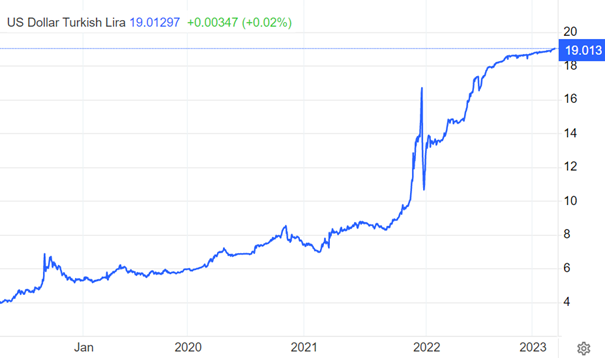As I read on Reuters, they are reporting that the big reason for the massive fall are earthquakes that hit the country last month. This is believed to make investors cautious when approaching to trade the Turkish currency or anything in connection with them. The next possible reason is said to be presidential and parliamentary elections, which are scheduled for 14th of May. However, based on past elections, I am not expecting any shocking news, apart from Erdogan staying on the position. Despite my believes, it can still be a very shocking event, as the country will decided if they will continue with unorthodox policies, or revert as it was promised by opposition.
Moving on, Turkey’s Treasury said that it had borrowed 2,25 billion USD in a Eurobond issue maturing in 2029. The total amount of borrowed money this year accumulated to 5 billion USD. Despite this, lira lost 30% against dollar this year alone. * I also read, that many are expecting lira to hover around the mark of 19, at least until elections are finished. In case that opposition wins, it is expected that lira will rise sharply, as the opposition would present more conventional policy. [1]
Another thing that I had to keep in mind is that Turkey’s inflation rate in October last year was 86% but dropped to “only” 58% in January. This caused the central bank of Turkey to raise interest rates to 9%. However, not long after that they lowered the rates to 8,5%.
I thought to myself that I have gathered enough fundamental information, so I decided to check the charts and numbers. I didn’t have much work with the chart, as it is immediately clear that the way for this pair is up – meaning, lira to keep losing value against USD. However, with all the bank problems, USD will also be unstable, so I will approach the pair very carefully. Five years ago, the exchange rate was around 4 liras for 1 USD. Because of the problems that Turkey is facing lately, this exchange rate jumped to 19. I decided to open position on long, however, when elections will be nearing, I will keep an eye on it.

Movement of USDTRY in the last five years. (Source: Trading Economics) *
* Past performance is no guarantee of future results.
[1] Forward-looking statements are based on assumptions and current expectations, which may be inaccurate, or based on the current economic environment which is subject to change. Such statements are not guaranteeing of future performance. They involve risks and other uncertainties which are difficult to predict. Results could differ materially from those expressed or implied in any forward-looking statements.








